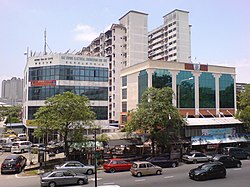Sungai Pinang
Sungai Pinang | |
|---|---|
| Other transcription(s) | |
| • Jawi | سوڠاي ڤينڠ |
| • Chinese | 双溪槟榔 |
 | |
 Sungai Pinang Location of Sungai Pinang in George Town, with the city centre's UNESCO World Heritage Site in purple. | |
| Coordinates: 5°24′24.5514″N 100°19′10.6896″E / 5.406819833°N 100.319636000°ECoordinates: 5°24′24.5514″N 100°19′10.6896″E / 5.406819833°N 100.319636000°E | |
| Country | |
| State | |
| District | Northeast Penang Island |
| City | |
| Government | |
| • Local government | Penang Island City Council |
| • Mayor of Penang Island | Yew Tung Seang |
| • Sungai Pinang State Assemblyman | Lim Siew Khim (DAP) |
| • Jelutong Member of Parliament | RSN Rayer (DAP) |
| Time zone | UTC+8 (MST) |
| • Summer (DST) | Not observed |
| Postal code | 10150 |
| Website | mbpp |
Sungai Pinang is a residential neighbourhood along the Pinang River within the city of George Town in Penang, Malaysia. The neighbourhood, bounded by the river to the north and Jalan Sungai Pinang to the south, is also geographically part of the Jelutong suburb.
The neighbourhood includes a number of Malay and Indian villages, some of which have a history dating back to the 18th century.[1][2][3]
Etymology[]
The neighbourhood of Sungai Pinang was named after the Pinang River, which, in turn, is named after the Pinang palm, scientifically known as areca catechu.[4]
History[]

The Malay and Indian villages along the Pinang River date back to the 18th century, possibly predating Captain Francis Light's arrival on Penang Island in 1786.[3] Sumatran traders had arrived at the river's estuary in the 1780s and established settlements like Kampung Rawa and Kampung Makam.[1][2][3][5] Ethnic Tamils also settled along the river; whilst some professed their Muslim faith, others retained their Hindu beliefs and built a handful of Hindu temples along the river bank.
The existence of Muslim and Hindu places of worship located adjacent to one another had in the past provoked racial and religious tensions. In 1998, a minor religious clash broke out over the relocation of a Hindu temple at Kampung Rawa.[6][7] What had begun as an altercation over the relatively trivial issue of the noise levels of the Hindu prayer bells turned deadly, leaving four fatalities. Almost 200 rioters were arrested in response to the incident.
Among the more recent issues affecting this neighbourhood are the pollution of the Pinang River and perennial flash floods, as the neighbourhood sits on low-lying land adjacent to the river.[8][9][10] Efforts have been made by the Penang state government to clean up the Pinang River and alleviate the flash floods, including the use of technology and river dredging works.[11][12][13]
Transportation[]
Rapid Penang buses 12, 301, 302, 303 and 401 serve the neighbourhood, by connecting it with George Town to the north and other destinations within the southern side of Penang Island, including Bukit Jambul, Bayan Baru, Bayan Lepas, Batu Maung and Balik Pulau.[14][15][16][17][18]
Education[]
There is one Tamil-medium primary school and a Japanese international school within the Sungai Pinang neighbourhood.
Primary school
- SRJK (T) Jalan Sungai[19]
International school
- Penang Japanese School[20]
References[]
- ^ a b "Muslim Heritage in George Town" (PDF). George Town World Heritage Incorporated.
- ^ a b "Muslim Heritage in George Town" (PDF). George Town World Heritage Incorporated.
- ^ a b c "Newsletter September 2015" (PDF). Penang Heritage Trust.
- ^ Simon Gardner, Pindar Sidisunthorn and Lai Ee May, 2011. Heritage Trees of Penang, p. 206. Penang: Areca Books. ISBN 978-967-57190-6-6
- ^ Murugasu, Sheila (2017). The State and the Transnational Politics of Migrants: A Study of the Chins and the Acehnese in Malaysia. Springer. ISBN 9781137370617.
- ^ Dan Landis, Rosita D. Albert (2012). Handbook of Ethnic Conflict: International Perspectives. Springer. ISBN 9781461404484.
- ^ Rashid, Syerleena Abdul (2015-08-20). "Worsening inter-religious relations - Aliran". Aliran. Retrieved 2017-05-22.
- ^ Sekaran, R. "Flash floods hit Penang as Sungai Pinang bursts its banks – Nation | The Star Online". Retrieved 2017-05-22.
- ^ "Hentikan Pencemaran di Punca Untuk Sungai Pinang Yang Lebih Sihat dan Bersih | Buletin Mutiara". www.buletinmutiara.com. Retrieved 2017-05-22.
- ^ "Poor drainage cause of flash flood in Penang". 2016-10-29. Retrieved 2017-05-23.
- ^ "Penang signs RM5.8m deal to bring dead river back to life". 2014-05-15. Retrieved 2017-02-28.
- ^ "Sungai Pinang goes green with the help of technology". 2016-07-05. Retrieved 2017-02-28.
- ^ "Dredging work to start at Penang rivers – Nation | The Star Online". www.thestar.com.my. Retrieved 2017-05-23.
- ^ http://www.rapidpg.com.my/journey-planner/route-maps/details/12.gif
- ^ http://www.rapidpg.com.my/journey-planner/route-maps/details/301.gif
- ^ http://www.rapidpg.com.my/journey-planner/route-maps/details/302.gif
- ^ http://www.rapidpg.com.my/journey-planner/route-maps/details/303.gif
- ^ http://www.rapidpg.com.my/journey-planner/route-maps/details/401.gif
- ^ "SJK(T) JALAN SUNGAI – PULAU PINANG – Carian Sekolah Malaysia". www.sekolahmy.com (in ms-MY). Retrieved 2017-05-19.
{{cite web}}: CS1 maint: unrecognized language (link) - ^ "Main page". Penang Japanese School.
- Neighbourhoods in George Town, Penang
